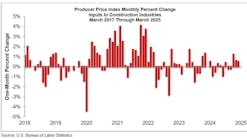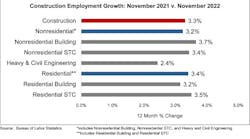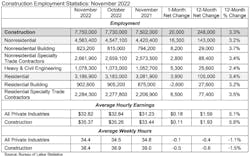PRESS RELEASES
WASHINGTON, Dec. 2—The U.S. construction industry added 20,000 jobs in November to reach a record-high 7,750,000, according to data released today by the U.S. Bureau of Labor Statistics.
On a year-over-year basis, industry employment has risen by 248,000 jobs, an increase of 3.3%. Nonresidential construction employment increased by 16,300 positions, with growth registered in all three subcategories. Nonresidential building added 8,200 new jobs, while heavy and civil engineering and nonresidential specialty trade added 5,300 and 2,800 jobs, respectively.
The construction unemployment rate fell to 3.9% in November, while unemployment across all industries remained unchanged at 3.7%.
“Today’s employment report will be celebrated by many, including jobseekers and other labor market participants,” said Associated Builders and Contractors (ABC) Chief Economist Anirban Basu. “Despite some recent high-profile layoffs, employers continue to hire aggressively and are increasing compensation in an effort to retain employees in the context of the ‘great resignation.’"
Added Ken Simonson, chief economist for Associated General Contractors of America (AGC): “It is heartening that both residential and nonresidential construction firms were able to add employees in November. But the number of job openings continues to outpace hiring, suggesting employers wanted to bring on many more workers than they are able to find.”
Pay levels in the construction industry continued to increase in November at a faster pace than in the overall private sector. Average hourly earnings for production and nonsupervisory workers in construction—mostly hourly craft workers—climbed by 6.1%, from $31.04 in November 2021 to $32.94 last month. That increase exceeded the 5.8% rise in average pay for all private sector production workers. Such workers in construction now earn an average of 17.2% more per hour than in the private sector as a whole.
“Normally, such dynamics would be celebrated by all,” said Basu. “However, for those who want inflation to abate, interest rates to fall and markets to be less volatile, the November jobs report is rather bad news. Those operating in real estate and construction are likely to be discouraged, as these segments are heavily influenced by interest rates, and rising borrowing costs make it more difficult to finance the next generation of construction projects."
Overall, the unemployment rate among jobseekers with construction experience decreased from 4.7% in November 2021 to 3.9% last month, tying the 2018 rate for the lowest ever for November. The number of unemployed construction workers fell by 16%, from 469,000 in November 2021 to 393,000 in November of 2022.
“While some will claim that this jobs report makes it less likely that recession is coming next year, the reality is quite the opposite,” claimed Basu. “The Federal Reserve will be forced to push interest rates higher for longer, and that makes a downturn more probable over the next 12 months.”
A separate government report on Wednesday showed there were 377,000 job openings in construction at the end of October, which exceeded the number of employees—341,000—hired during that month. The excess of job openings over hires indicated the industry wanted to hire more than twice as many workers as it was able to find in the current low-unemployment environment, Simonson said.
AGC officials noted they were taking steps to help, including running digital advertising recruiting campaigns and working to increase employee retention rates in the industry. But they warned that too few students are exposed to construction career opportunities in school as educators encourage most students to pursue college degrees and office jobs. As a result, high-paying construction positions remain unfilled while many college graduates struggle to pay off student loans in lower paying jobs.
“Public officials are missing a great opportunity to put many more people on the path to financial security,” said AGC Chief Executive Officer Stephen E. Sandherr. “Instead of encouraging students to amass even more debt, we should be exposing them to careers where they can earn a great living without worrying about unsustainable levels of college debt.”
##########










